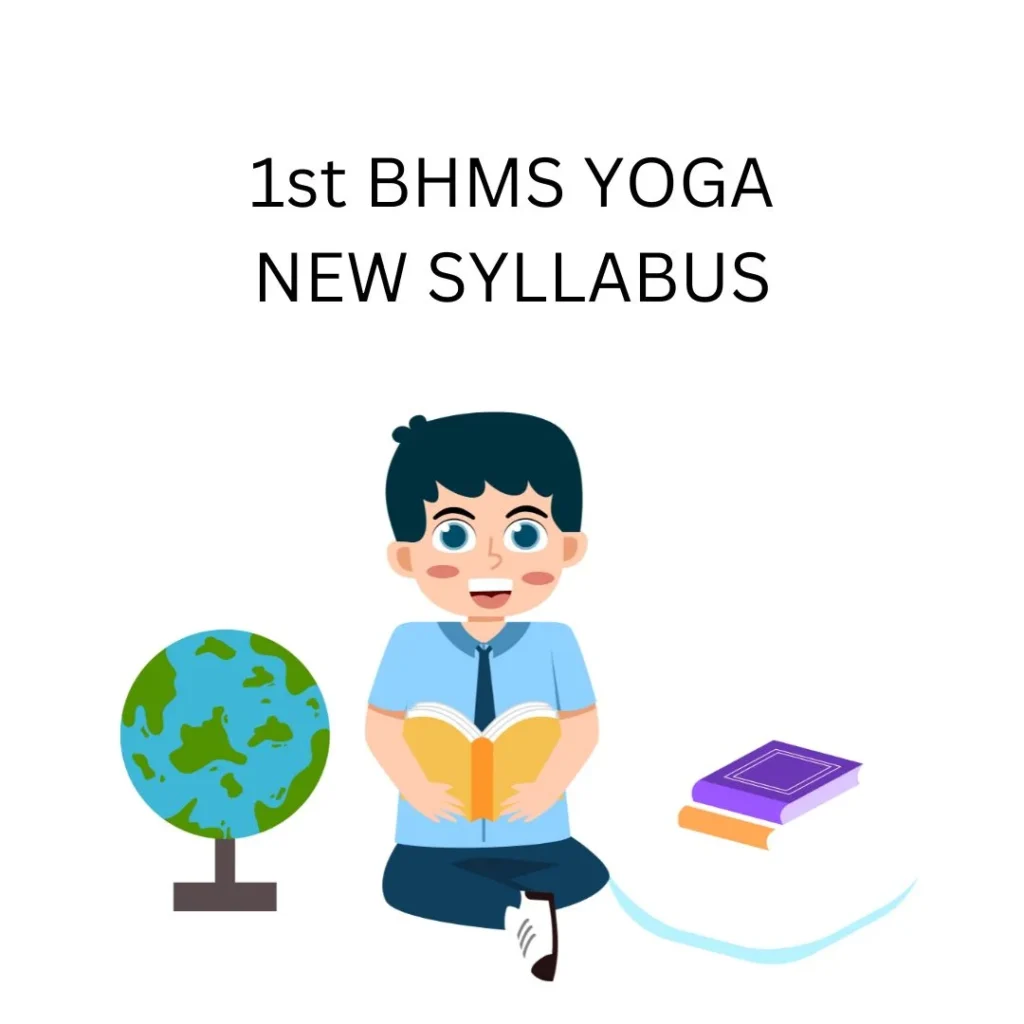Hey future homeopaths! 🎓 Are you ready to explore the world of Yoga as part of your 1st BHMS syllabus? Yoga is not just about physical postures; it’s a holistic practice that promotes physical, mental, and spiritual well-being.
This post provides a detailed breakdown of the Yoga syllabus for 1st BHMS students (2022-2023 onwards).
The 1st BHMS course includes 7 subjects other subjects are,
- Anatomy, Histology, and Embryology
- Human Physiology and Biochemistry
- Homoeopathic Pharmacy
- Homoeopathic Materia Medica
- Organon of Medicine and Philosophy
- Homoeopathic Repertory and Case Taking

Whether you’re new to yoga or looking to deepen your practice, this guide will help you understand the key concepts, benefits, and practical applications of yoga in homoeopathy. Let’s dive in!
Why Study Yoga in BHMS?
Yoga is an integral part of the holistic approach to health and healing. For homoeopathic students, yoga offers:
- Physical Benefits: Improved flexibility, strength, and posture.
- Mental Benefits: Reduced stress, enhanced focus, and emotional balance.
- Spiritual Benefits: A deeper connection with the self and the universe.
- Integration with Homoeopathy: Yoga complements homoeopathic principles by promoting vital force and overall well-being.
Yoga Syllabus: Detailed Breakdown
1. Introduction to Yoga
- Definition: What is yoga?
- Concept: The philosophy and purpose of yoga.
- Types: Different forms of yoga (e.g., Hatha, Ashtanga, Kundalini).
- Benefits: Physical, mental, and spiritual benefits of yoga.
- Origin: The historical roots of yoga in ancient India.
2. History and Philosophy of Yoga
- Patanjali’s Yoga Sutras: The foundational text of yoga philosophy.
- Development of Yoga: How yoga evolved over centuries.
- Ashtanga Yoga: The eight limbs of yoga (Yama, Niyama, Asana, Pranayama, Pratyahara, Dharana, Dhyana, Samadhi).
- Hatha Yoga: The practice of physical postures and breath control.
3. Asanas (Postures)
- Types of Asanas: Standing, sitting, lying, and balancing postures.
- Examples: Pawanmuktasana (wind-relieving pose), Surya Namaskar (sun salutation), and classical sequences.
- Benefits: Improved flexibility, strength, and relaxation.
4. Pranayama (Breath Control)
- Types: Abdominal, thoracic, and clavicular breathing.
- Techniques: Anulom Vilom (alternate nostril breathing), Kapalbhati (skull-shining breath), and Bhastrika (bellows breath).
- Benefits: Enhanced lung capacity, stress relief, and mental clarity.
5. Kriyas (Cleansing Techniques)
- Types: Neti (nasal cleansing), Dhauti (digestive tract cleansing), and Trataka (eye cleansing).
- Benefits: Detoxification and purification of the body.
6. Meditation
- Types: Mindfulness, transcendental, and guided meditation.
- Methods: Sitting postures, Om chanting, and Trataka (candle gazing).
- Benefits: Improved focus, emotional balance, and inner peace.
7. Relaxation Techniques
- Short Yoga Nidra: A guided relaxation practice.
- Savasana (Corpse Pose): Deep relaxation and stress relief.
- Sankalpa (Resolution): Setting positive intentions during relaxation.
8. Correlation of Yoga and Homoeopathy
- Vital Force and Prana: Understanding the connection between the vital force in homoeopathy and prana in yoga.
- Holistic Approach: How yoga complements homoeopathic treatment.
- Accessory Circumstances: Applying yoga as an accessory to homoeopathic treatment, as suggested by Hahnemann.
Practical Training in Yoga
The 1st BHMS Yoga syllabus includes 30 hours of practical training. Here’s what you’ll learn:
1. Asana Practice
- Pawanmuktasana: A series of postures for joint mobility and relaxation.
- Surya Namaskar: A sequence of 12 postures for overall fitness.
- Back Stretching: Postures to improve spinal flexibility.
2. Pranayama Practice
- Abdominal Breathing: Deep breathing to enhance lung capacity.
- Vilom Pranayama: Alternate nostril breathing for balance and calm.
- Lung Sensitizing: Techniques to improve respiratory health.
3. Meditation Practice
- Sitting Postures: Comfortable positions for meditation.
- Om Chanting: Using sound vibrations for relaxation.
- Trataka: Candle gazing for improved focus.
4. Relaxation Techniques
- Tense and Relax: A method to release physical tension.
- Yoga Nidra: A guided practice for deep relaxation.
Tips to Excel in Yoga
- Practice Regularly: Consistency is key to mastering yoga.
- Focus on Breath: Pay attention to your breathing during asanas and pranayama.
- Stay Mindful: Be present in the moment during meditation and relaxation.
- Correlate with Homoeopathy: Understand how yoga enhances the vital force and complements homoeopathic treatment.
Why Yoga Matters in Homoeopathy
Yoga is not just a physical practice; it’s a holistic approach to health and healing. For homoeopathic students, yoga offers:
- Enhanced Vital Force: Yoga strengthens the body and mind, supporting the vital force.
- Stress Relief: Yoga helps manage stress, a common cause of illness.
- Holistic Healing: Yoga complements homoeopathic treatment by addressing the physical, mental, and spiritual aspects of health.
This post is designed to help you study smarter, not harder.
Let me know if you need further tweaks!
- 1ST BHMS NEW SYLLABUS 2022-2023: SUBJECTS, EXAM PATTERN, AND STUDY TIPS FOR STUDENTS
- 1ST YEAR BHMS EXAM PATTERN (2022-2023) – COMPLETE GUIDE WITH SUBJECT-WISE MARKS & STUDY TIPS
- 1ST BHMS NEW ANATOMY SYLLABUS: A DETAILED GUIDE FOR STUDENTS (2022-2023 ONWARDS)
- 1ST BHMS ANATOMY EXAM GUIDE: IMPORTANT QUESTIONS FOR PAPER 1 & PAPER 2 (2022-2023)
- 1ST BHMS PHYSIOLOGY AND BIO-CHEMISTRY NEW SYLLABUS: A DETAILED GUIDE FOR STUDENTS (2022-2023 ONWARDS)
- 1ST BHMS PHYSIOLOGY & BIO-CHEMISTRY EXAM GUIDE: IMPORTANT QUESTIONS FOR PAPER 1 & PAPER 2 (2022-2023)
- 1ST BHMS HOMOEOPATHIC PHARMACY SYLLABUS: A COMPLETE GUIDE FOR STUDENTS (2022-2023)
- 1ST BHMS HOMEOPATHIC PHARMACY PRACTICAL SYLLABUS GUIDE: ESSENTIAL EXPERIMENTS & HIGH-YIELD TOPICS (2022-2023)
- LATEST HOMOEOPATHIC PHARMACY QUESTION BANK FOR BHMS STUDENTS (2022-2023 SYLLABUS)
- 1ST BHMS HOMOEOPATHIC REPERTORY AND CASE TAKING: A COMPLETE GUIDE FOR STUDENTS (2022-2023)
- 1ST BHMS ORGANON OF MEDICINE, HOMOEOPATHIC PHILOSOPHY, AND PSYCHOLOGY: A COMPLETE GUIDE FOR STUDENTS (2022-2023)
- 1st BHMS COMPLETE THEORY QUESTION BANK: ORGANON OF MEDICINE, PHILOSOPHY & PSYCHOLOGY (2022-2023 SYLLABUS
- 1ST BHMS HOMOEOPATHIC MATERIA MEDICA SYLLABUS: A COMPLETE GUIDE FOR STUDENTS (2022-2023)
- 1ST BHMS HOMOEOPATHIC MATERIA MEDICA QUESTION BANK: SYLLABUS, REMEDIES, AND EXAM PREP
